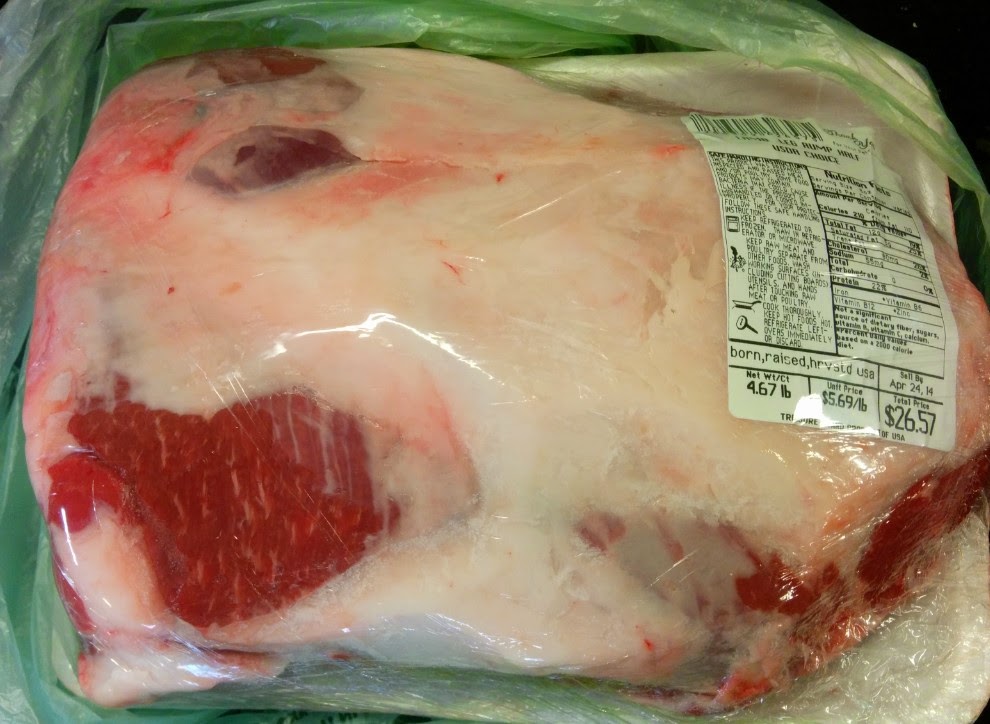As usual, we had leg of lamb for Easter! I was really excited to sous-vide it, because leg of lamb is a cut with wide swaths of fairly lean meat, yet also a decent amount of connective tissue. So I hypothesized that it would really benefit from an extended stay in the water bath. I did 24 hours at 137 degrees F, but next time I might even go down to 12 as it did not need that much tenderizing.
Before we get to the cooking, though, I want to say a quick word about how I trim meat. Look at this leg:
There's a pretty thick fat cap. People tend to either take it all off or leave it all on, but I think that's missing a great opportunity. My goal is to take
most of it off, leaving just a thin layer of fat:
It doesn't require super butcher skills. It doesn't have to be pretty. Just make it look something like that, and don't worry, it will be beautiful after it cooks.
Ode to crispy fat.
Shall I compare thee to a simmer's bay leaf?
No, because that would be silly. But I will tell you why you should bother to follow my trimming instructions.
You should bother because there's nothing so delicious as browned, crispy fat, and only the outermost surface of the fat will ever get crispy. Non-crispy fat can be good too, although frankly it doesn't hold a candle to crispy fat, and if you leave a lot of fat on, most Americans will simply cut it all off anyway. But everyone loves a thin layer of crispy fat.
I mean, that's basically what bacon is. That's the reason everyone loves bacon, even though it is 50% fat, even though they trim the fat off their steak without a second thought.
Nevertheless, you could conceivably go your whole life without explicitly noticing that crispy fat is the component producing max deliciousness. So I'm here to beat you over the head with this obvious-in-retrospect fact. It's easy to verify. The next time you are trimming your steak at the table, try cutting off the very outer edge of the fat and eating it. You won't be disappointed.
And, by the way, I think you should mostly ignore recipes that tell you to leave a big fat cap so the meat will be basted while it roasts in the oven. Basting action can serve a purpose (effectively frying the outside of the roast), but a little goes a long way, and fat takes a long time to render. After the roast is done, you will probably be left with a thick layer of all the unrendered fat that did not baste your meat, so what was the point of it? If you happen to be surrounded by people who like to eat that stuff, then by all means, leave it on. Otherwise, you can get 95% of the flavor boost with 5% of the waistline boost by trimming most of it away.
Results.
Anyway, so I bagged the lamb with olive oil, garlic, and thyme:
After cooking, the lamb was quickly seared, to produce this:
I served it with carrots and asparagus, and Israeli couscous which I combined with my egg-lemon soup recipe, which turned out to be a really good idea:
As you can see, the meat is perfectly pink. There is no visible fat, only a thin crispy layer working its invisible magic on the look and taste of the final product.
To Victory!
And now I would like to make a very special announcement: Victory!
As we know, lamb is an acquired taste, and one that most Americans have not acquired.
Less than one pound of lamb is consumed for every 100 pounds of chicken in the US. And there was a time when Catherine too did not like lamb. She would eat it, but only begrudgingly. I have worked hard to change that, because lamb is one of my very favorite meats.
Recent months have seen considerable progress. First, she started to complain when I would cook lamb for myself and chicken for her. Then I started to get
actual positive reactions. And with this dish, I got a genuine rave review!
 |
| Wolf me down, and your journey towards the lamb side will be complete! |
Furthermore, I have since replicated my results with a lamb shoulder roast (forthcoming), so it wasn't just a fluke. It's safe to say that Catherine now loves lamb, just like me and many of my fellow Vongsas. Huzzah! It's only fitting, now that she's a Vongsa too :)


























